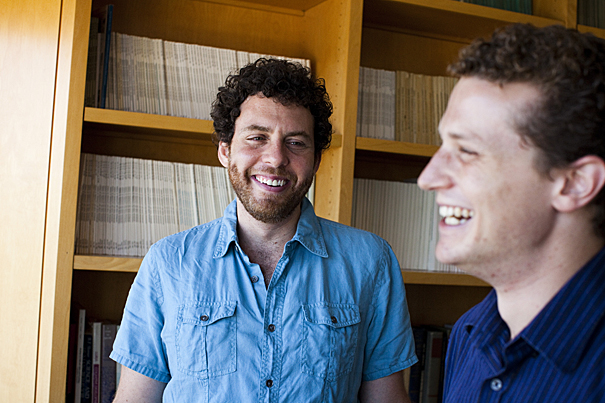
Joshua Greene (left) and Amitai Shenhav have found that people make major moral decisions using the same brain circuits used for more mundane choices, like spending money or choosing food.
Stephanie Mitchell/Harvard Staff Photographer
What’s right for me?
General brain circuits process moral decisions as readily as they do everyday choices
Scientists at Harvard University have found that humans can make difficult moral decisions using the same brain circuits as those used in making more mundane choices related to money and food.
These circuits, also found in other animals, put together two critical pieces of information: How good or bad are the things that might happen? What are the odds that they will happen, depending on one’s choice? The results suggest that complex moral decisions need not rely on a specific “moral sense.”
Amitai Shenhav and Joshua D. Greene of Harvard’s Department of Psychology presented the findings in the latest edition of the journal Neuron.
“It seems that our capacity for complex, life-and-death decisions depends on brain structures that originally evolved for making more basic, self-interested decisions about things like obtaining calories,” said Shenhav, a doctoral student in psychology at Harvard. “Many of the brain regions we find to be active in major moral decisions have been shown to perform similar functions when people and animals make commonplace decisions about ordinary goods, such as money and food.”
Some researchers have argued that value judgments are produced by a “moral faculty” in the brain, but Shenhav and Greene’s work indicates that at least some moral decisions rely on general mechanisms also used by the brain in evaluating other kinds of choices.
“Research in neuroeconomics has identified distinct brain structures responsible for tracking the probability of various outcomes, the magnitude of various outcomes, and for integrating these two kinds of information into a decision,” said Greene, an assistant professor of psychology at Harvard. “Our work shows that the parts of the brain people use for this last task — combining assessments of outcome probability and magnitude into a final decision — closely coincide with the brain regions we use daily when deciding how to spend money or choose foods.”
Using real-time brain imaging, Shenhav and Greene presented 34 subjects with hypothetical choices between saving one life with certainty or saving several lives, but with no guarantee that this latter effort will succeed. The experiment systematically varied the number of lives at risk and the odds of success.
The authors found that a brain region called the ventromedial prefrontal cortex tracked the “expected moral value” of the uncertain option, integrating information about the number of lives to be saved and the probability of saving them. Other brain regions separately tracked outcome magnitude and outcome probability.
The work advances understanding how people make decisions affecting the lives of others. Many of the most consequential such decisions are made by policymakers: In some cases, a single choice can change thousands of lives.
“For example, how did President Truman decide to deploy nuclear weapons against Japan in 1945, ending World War II, but at an enormous cost?” asked Greene. “Our results suggest that such decisions employ the same basic mechanisms our brains use when we evaluate whether it’s worth spending a few hundred dollars for an extended warranty on a new car.”
Truman’s historic decision shows parallels to ones made by ordinary people every day. It involved tradeoffs among outcomes of different magnitude: How many lives would be lost? How many saved? Second, Truman’s decision was made in uncertainty. He could, at best, assign probabilities to possible outcomes.
Likewise, everyday decision makers must compare the relative sizes of costs and benefits, as when a car buyer balances the cost of a warranty against the cost of repairs. The consumer doesn’t know at the outset whether he or she will have to pay for expensive repairs down the road.
“Truman, like ordinary decision makers, had to put information about probability and magnitude together to reach a decision,” Shenhav said. “And, like the car buyer, Truman likely relied on his ventromedial prefrontal cortex to evaluate his options.”
Shenhav and Greene’s research was funded by the National Science Foundation.





